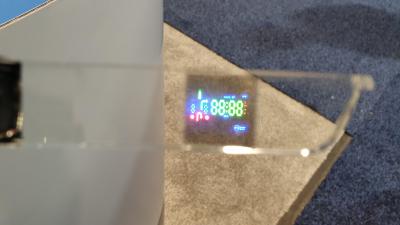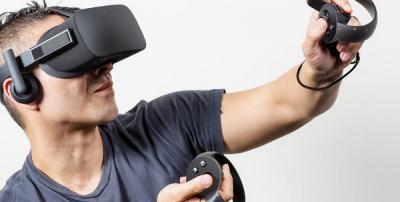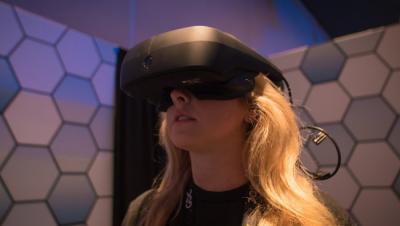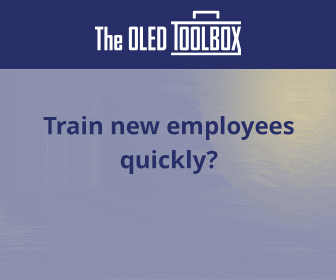 Meta is one of the world's largest companies, operating social media services such as Facebook, Instagram, Whatsapp and more.
Meta is one of the world's largest companies, operating social media services such as Facebook, Instagram, Whatsapp and more.
Meta is highly involved with AR and VR technologies. In 2014, Meta (then Facebook) acquired VR headset developer Oculus. The company has since released several VR headsets, based on LCD and AMOLED displays. Meta is mostly focused on AR solutions. In 2024 it announced its Orion prototype headset, based on microLED microdisplays.
1 Hacker Way
Menlo Park, CA 94025
United States
Plessey and Meta develop a 6 million nits 5 micron microLED microdisplay
Plessey Semiconductors, together with Meta Platforms, announced that they have developed a native red microLED microdisplay that achieves up to 6 million nits with a chip size of 5 um. Plessey says that this is world's brightest microLED device at this size.
In March 2020, Meta signed a deal with Plessey to dedicate all of Plessey's microLED manufacturing operations to support Meta with its own product development. Facebook pretty much acquired Plessey's microLED operations with this exclusive deal.
Meta announces $10,000 AR glasses powered by microLED microdisplays
Meta announced a new AR headset, called Orion. The glasses, that Meta says costs $10,000 to produce (and will probably be sold to something like that as well) are powered by microLED microdisplays. Orion packs quite advanced technology, including Silicon Carbide lens and advanced AI, but this is of course actually a prototype device, that Meta will offer commercially to developers or (very) early adopters. The Orion glasses weigh 98 grams, which still way more than what people consider to be light weight glasses (usually under 30 grams).
It is very nice to see the adoption of microLED technology by Meta. While some speculate that these microLED displays are made in-house by Meta using the Plessey Semiconductor technology and production line, it is also known that the company gave up on that course, and others speculate that these displays are produced by JBD, and are made from 3 separate monochrome microLED panels.
MicroLED-based AR and VR display innovation to be featured at MicroLED-Connect 2024
MicroLED-Connect is the world's first dedicated MicroLED conference and exhibition. The event, organized by TechBlick and the MicroLED Association, will take place at the High Tech Campus in Eindhoven, also known as "the smartest square kilometer in all of Europe", and will include an excellent conference program, masterclasses, tours - with a special emphasis on social/professional gatherings and networking opportunities.
One of the themes to be highlighted at the event is AR/VR, which is perceived as one of the key markets for microLED display makers thanks to the high-brightness and efficiency of microLEDs - making them an excellent candidate to drive future AR and VR headsets and products.
Reports suggest Meta is abandoning Plessey's microLED microdisplay technology and processes
In March 2020, Facebook (now Meta) signed a deal with UK-based MicroLED microdisplay developer Plessey Semiconductor to dedicate all of Plessey's microLED manufacturing operations to support Facebook with its own product development. Facebook pretty much acquired Plessey's microLED operations with this exclusive deal.

Facebook hoped to utilize microLED microdisplays in future AR headsets. According to a new report, the company has decided to use LCoS microdisplays for its first consumer AR device, codenamed Artemis, which will be released (if all goes according to plan) in 2027. It seems as if the development based on Plessey's technology and processes did not progress as expected, and Meta did not manage to develop high brightness microLEDs or a process with satisfactory yields.
Meta launches a 5 million Euro AR research project at Tyndall National Institute
Meta announced that has entered into a research partnership with Ireland-based deep-tech research centre Tyndall National Institute. Tyndall launched a four-year project to help advance AR technologies.
Meta will invest €5 million in this project, which will focus on key AR technologies, including the investigation of the efficiency of microLED microdisplays based systems. The project will be led by Prof. Paul Hurley.
Reports suggest that Meta is in talks with Samsung and LG regarding the future supply of microLED microdispaly
In August 2022, we posted that both Samsung Display and LG Display started to develop microLED microdisplay technologies. According to a new report from Korea, Meta is in talks with both Korean companies regarding the future supply of both OLED and MicroLED microdisplays.

It is said that Samsung targets AR devices with its microLED microdisplay technology, while it targets VR devices with its OLED microdisplays. Samsung's microLED displays will achieve a resolution of 6,000 to 7,000 PPI (higher than its OLED devices).
MicroLED Microdisplays - quick market snapshot
This article is an extract from The MicroLED Handbook, 2020 edition, and gives a short introduction to the current market status of MicroLED Microdisplays. The handbook was published in January 2020 - there has been some updates since then, for example Plessey's recent soft-acquisition by Facebook and MICLEDI's technology was revealed.
There are several companies that develop microLED microdisplays, and these are gearing up to begin mass production of displays soon. It is likely that microdisplays will be the first type of commercial displays enabled by microLED technology.
Plessey signs deal with Facebook to dedicate all of its MicroLED operations to support Facebook's AR project
UK-based GaN-On-Si MicroLED microdisplay developer Plessey Semiconductor announced a partnership with Facebook - in fact Plessey will dedicated all of its manufacturing operations to support Facebook with its own product development.

Plessey says that its displays will be used to support Facebook's prototypes, and the company will develop new microLED technologies to future AR/VR applications.
Taiwan's ITRI to build a pilot line for micro-LED VR displays by Q3 2018
Earlier this month we reported that Taiwan's Electronic and Optoelectronic System Research Laboratories (EOSRL, part of ITRI) has launched a project that aims to develop Micro-LED displays for large-area signage indoor displays.

LGD VR prototype, March 2017
According to a new report from Taiwan, EOSRL's new line, which will begin operation in Q3 2018, will be also used to produce small displays for VR applications. EOSRL reveals that the pilot line is already able to handle 2500 (50x50) chips per transfer, and by the time it is ready it will be able to handle 100,000 chips (100x100).







